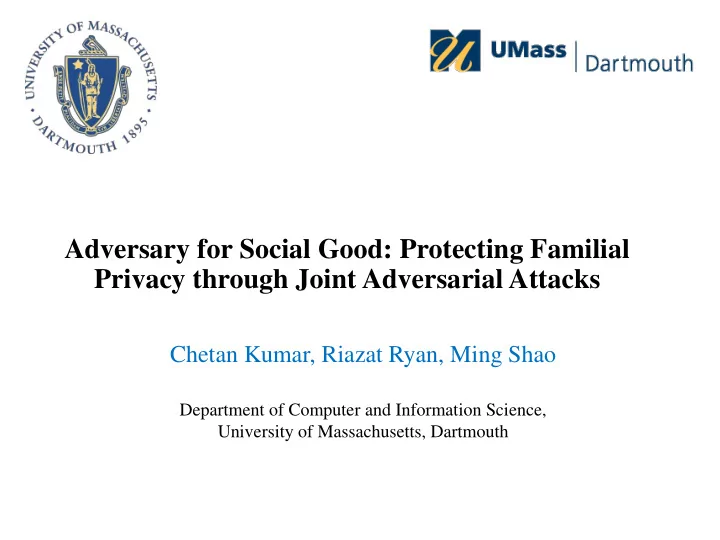

Adversary for Social Good: Protecting Familial Privacy through Joint Adversarial Attacks Chetan Kumar, Riazat Ryan, Ming Shao Department of Computer and Information Science, University of Massachusetts, Dartmouth
Data Leakage: ▪ Limited time to read Terms & Conditions ▪ Limited knowledge (especially children) to understand ▪ Unintentional leakage
Behavioral Targeting: Visitor comes to Visitor clicks the Your ads display your site & leaves ad and comes on other sites without shopping back to your site ▪ Already developed Advanced Algorithms to analyze users’ personal data and identity: ▪ Shopping Habits ▪ Movie Preferences ▪ Reading Interests ▪ etc.
Motivation: ▪ Image recognition has achieved ▪ Generally, people have no significant process in the past willing to disclose personal decade data Image Classification on ImageNet ▪ Visual kinship understanding drawing more attention
Motivation: ▪ Graph Neural Network (GNN) ▪ GNN provides a new perspective for learning with Graph ▪ It may promote familial feature learning and understanding ▪ Social Media ▪ Social Media is mainly featured by sharing photos and social connections (friend, relative, etc.) ▪ Learning models with social media data can be developed towards various goals ▪ Unfortunately, it may lead to information leakage and expose privacy w/ or w/o intention ▪ You can imagine how furious a celebrity will be when their family members photos are exposed without their permission
Privacy Leakage over Social Media: Photo Clicked by a Person
Privacy Leakage over Social Media: Photo Clicked Family Information by a Person Searched over the Web
Privacy Leakage over Social Media: Photo Clicked Family Data is Family Information by a Person Searched over the Web Found
Family Recognition on the Graph: ▪ 𝐻 = (𝑊, 𝐹) an attributed and undirected graph ▪ The adjacency matrix 𝐵 ∈ {0, 1} 𝑂×𝑂 ▪ 𝑌 ∈ ℝ 𝑂×𝐸 represents node features ▪ 𝑌 𝑀 ∈ ℝ 𝐸×𝑂 𝑀 and 𝑌 𝑉 ∈ ℝ 𝐸×𝑂 𝑉 be the labeled and unlabeled image features ▪ 𝑧 𝑀 ∈ ℝ 𝑂 𝑀 is the label vector ▪ Goal is to find the mapping: 𝒈 𝑯 : 𝒀 𝑴 , 𝒀 𝑽 → ([𝒛 𝑴 , 𝒛 𝑽 ])
Graph Construction: ▪ IDs (Identities) ▪ NN (Nearest Neighbor) ▪ Kin (Family Relation) Family 1 Kin Identities Family 2 Nearest Neighbor Original Features + Graph
Model Learning: Where, ▪ 𝐵’ = (𝐵 + 𝐽) 𝐼 (𝑚) = σ [ 𝐸′ −1 2 𝐵 ′ 𝐸′ −1 2 𝐼 𝑚−1 𝑋 (𝑚−1) ] to add self-loops ▪ 𝐸′ is the Degree Matrix of 𝐵’ to normalize large Output to degree nodes next Normalize Graph ▪ 𝐼⁰ = 𝑌 layer/Result Structure Multiply Node ReLU Function Parameters and Weights
Model Framework: ▪ Privacy at Risk ▪ Social media data may expose sensitive personal information ▪ This can be leveraged and lead to information leakage without user's attention Sneak Photo Original Feature + Graph
Model Framework: ▪ Adversarial Attack: ▪ Added Noise to Node Features by calculating sign of the Gradient ▪ Added/Removed edges (relationships) between nodes Sneak Adversarial Adversarial Labeled Noise Image Image Photo Original Features + Adversarial Features Graph + Graph
Model Framework: ▪ Model Compromised: ▪ By using Noisy Features and Noisy Graph
Algorithm: No if below Clean Train/Re-train GNN model Budget? Data Yes Perturb Node Perturb Graph Features Structure Graph loss = Feature loss = Calculate Model Loss Calculate Model Loss Update Node Yes Features only Feature loss > Update Graph Graph Loss? Test on No only Clean Data
Joint Feature and Graph Adversarial Samples The proposed joint attack model can be formulated as: Here, ▪ 𝑀 𝐵𝐸 is the loss function of the joint attack ▪ ||. || 𝐺 is the matrix Frobenius norm ▪ λ is the balancing parameter ∗ ▪ 𝑎 𝑞𝑓𝑠𝑢 is the softmax output of the perturbed labeled data ∗ ▪ 𝑎 𝑑𝑚𝑓𝑏𝑜 is based on clean features and graph
Datasets: Families in the Wild (FIW)
Datasets: ▪ Pre-processing ▪ Extracting image features using pre-trained SphereNet ▪ Constructed the social graph (IDs, Kin, k- NN) ▪ Created two social networks ▪ Family-100 ▪ Contains 502 subjects ▪ 2758 facial images ▪ 502/2758 nodes for training ▪ 2256 for validation and testing ▪ Family-300 ▪ Contains 1712 subjects ▪ 10255 facial images ▪ 1712/10255 for training ▪ 8543 for validation and testing
Results: ▪ Impacts of graph parameters ▪ Best value for k = 2 ▪ Best value for ID and Kin= 5
Results: Joint Feature and Graph Adversarial Samples 𝑈𝑝𝑢𝑏𝑚 − 𝐶𝑣𝑒𝑓𝑢 = λ ∗ Edge−Flipping−Ratio + (1−λ) ∗ 100 ∗ 𝜗 Family-100 ▪ Single Attack ▪ Feature only and graph only attacks are implemented ▪ But excessive use of any particular attack compromises the data largely, i.e., perceivable visual change ▪ Joint Attack ▪ We propose a joint attack which proves more cost- efficiency
Results: Joint Feature and Graph Adversarial Samples Family-300 ▪ Single Attack ▪ Joint Attack
Results: Loss and Accuracy on Family-100 ▪ Run the Joint Attack Algorithm for 13 iterations ▪ Average result for 5 trials ▪ Accuracy decreased with more iterations ▪ And Model Loss is increasing
Qualitative Evaluation: Impacts of ∈ on image and node features ▪ High-dimensional raw image data require weak noise to fool the model ▪ Low-dimensional visual features require relatively strong noise to fool the model
Conclusion: ▪ Demonstrated the family information was at risk on social network through plain graph neural networks ▪ Proposed a joint adversarial attack modeling on both features and graph structure for family privacy protection ▪ Qualitatively showed the effectiveness of our framework on networked visual family datasets ▪ Future extension: Adapt our modeling to different types of data and other privacy related issues
Acknowledgement: We gratefully acknowledge the support of NVIDIA Corporation with the donation of the Titan X Pascal GPU used for this research.
References: 1. https://techcrunch.com/2014/05/19/netflix-neil-hunt-internet- week/ 2. https://www.business2community.com/marketing/multiple- benefits-retargeting-ads-01561396 3. https://blog.ladder.io/retargeting-ads/ 4. https://reelgood.com/movie/terms-and-conditions-may-apply- 2013 5. https://clclt.com/charlotte/cucalorus-report-part- 3/Content?oid=3263928 6. https://www.capitalxtra.com/terms-conditions/general/ 7. https://paperswithcode.com/sota/image-classification-on- imagenet
Q & A Thank you www.chetan-kumar.com http://www.cis.umassd.edu/~rryan2/
Recommend
More recommend